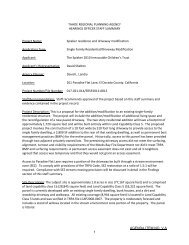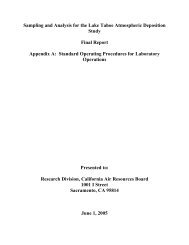FEIS - Tahoe Regional Planning Agency
FEIS - Tahoe Regional Planning Agency
FEIS - Tahoe Regional Planning Agency
Create successful ePaper yourself
Turn your PDF publications into a flip-book with our unique Google optimized e-Paper software.
RESPONSE TO COMMENTS ON THE DEIS<br />
B o u l d e r B a y C o m m u n i t y E n h a n c e m e n t P r o g r a m P r o j e c t E I S<br />
Table 8.5-1<br />
Comparison of total Runoff Volumes for Various Designs and Storms for<br />
Project Area BMP Designs<br />
Project Area BMPs/SWMP<br />
EC<br />
Existing<br />
Conditions<br />
E20<br />
Existing<br />
Conditions (20<br />
yr Design)***<br />
C20<br />
Alternative C<br />
(20 yr Design)<br />
C100<br />
Alternative C<br />
(100 yr Design)<br />
BMP Capacity (CF) 500 22,647 39,079 58,152<br />
LID elements (green roofs, pervious<br />
pavers, cisterns) (CF)** none<br />
Notes:<br />
none none 12,838<br />
Total Capacity 500 22,647 39,079 70,990<br />
20 yr - 1 hr storm Volume (CF) 39,075 39,075 39,075 39,075<br />
Storm Volume Runoff (CF) 38,575 16,428 -4* -31,915*<br />
50 yr - 1 hr storm Volume (CF) 48,844 48,844 48,844 48,844<br />
Storm Volume Runoff (CF) 48,344 26,197 9,765 -22,146*<br />
100 yr - 1 hr Storm Volume (CF) 60,566 60,567 60,567 60,567<br />
Storm Volume Runoff (CF) 60,066 37,920 21,488 -10,423*<br />
* A negative storm volume runoff represents excess design capacity for the storm event.<br />
** For C100, an estimate of capacity for the LID strategies is included for comparison purposes. The actual capacity varies for<br />
the loading calculations depending on antecedent moisture due to previous weather.<br />
*** E20 results in runoff for the 20-year storm due to the contribution of NDOT and Washoe County ROW. E20 does not<br />
include capacity for theses surfaces.<br />
Appendix AB of the <strong>FEIS</strong> provides the detailed results and conclusions from the LSPC modeling<br />
exercises. The results and conclusions are summarized in the follow bullets:<br />
• Dry Water Years (1993-1994 and 2007-2008) –<br />
o Implementation of C20 SWMP reduces loading compared to EC in both dry<br />
years by roughly 50 percent.<br />
o Implementation of C100 SWMP contains the stormwater runoff completely such<br />
that there is minimal to no discharges to down-gradient drainage and stormwater<br />
systems and ultimately Lake <strong>Tahoe</strong>.<br />
PAGE 8- 14 HAUGE BRUECK ASSOCIATES SEPTEMBER 8 , 2010






